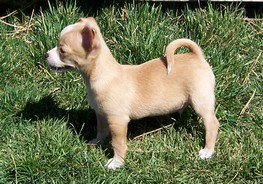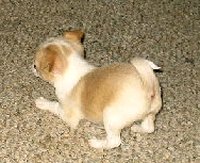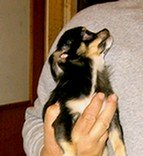|
Dog Body LanguageKnowing your dog's body language is the key to understanding your dog, assessing her attitude, and predicting her next move. Because dogs are non-verbal - their body language does the talking for them. Understanding their body language can also help protect you and your dog from dangerous situations Learn to recognize these common body languages...
Confident
The confident dog stands straight and tall with her head held high, ears perked up, and eyes bright. Her mouth may be slightly open but is relaxed. Her tail may sway gently, curl loosely or hang in a relaxed position. She is friendly, non-threatening and at ease with what’s going on around her.
HappyA happy dog will show these same signs. She will usually wag her tail and sometimes hold her mouth open more or even pant mildly. Appears even more friendly and content, with no signs of anxiety.
Playful
A playful dog body language is happy and excited. The ears are up, eyes are bright, and tail wags rapidly. She may jump and run around with glee. Often, a playful dog will give the "play bow" - front legs stretched forward, head straight ahead, rear end up in the air and possibly wiggling. This is clearly an invitation “play with me“! Submissive
Submissive dogs hold their head down, ears down flat and averts her eyes. The tail is low it may sway a little, but not tucked. She may roll on her back and expose her belly. A submissive dog may also nuzzle or lick the other dog or person to show even more passive intent. A submissive dog is meek, gentle and non-threatening. AnxiousThe anxious dog body language may look somewhat submissive, but often ears partially held back and her neck stretched out. She stands in a very tense posture and sometimes shudders. An anxious dog may whimper or moan. Tail is low and may be tucked. This dog may overreact to stimulus and can become fearful or even aggressive. If you are familiar with the dog, you may try to divert her attention to something more pleasant. However, be cautious - do not provoke her or try to soothe her. FearfulThe fearful dog combines both submissive and anxious attitudes with more extreme signals. She stands tense, but is very low to the ground. Her ears are flat back and her eyes are narrowed and averted. Her tail is between her legs and she typically trembles. A fearful dog often whines or growls and might even bear her teeth in defense. She may also urinate or defecate. A fearful dog can turn aggressive quickly if she senses a threat. Do not try to reassure the anxious dog, but walk away from the situation calmly. If you are the owner, be confident and strong, but do not comfort or punish your dog. Try to move her to a less threatening, more familiar location.
DominantA dominant dog will try to assert herself over other dogs and sometimes people. They stand tall and confident and may lean a bit forward. Eyes are wide and makes direct eye contact with the other dog or person. Ears are up and alert, and the hair on their back may stand on edge. She may growl lowly. Dog Body Language here appears less friendly and possibly threatening. If the behavior is directed at a dog that submits, there is little concern. If the other dog also tries to be dominant, a fight may break out. A dog that directs dominant behavior towards people can pose a serious threat. Do not make eye contact and slowly try to leave. If your dog exhibits this behavior towards people, behavior modification is necessary.
Aggressive
An aggressive dog body language goes far beyond dominant. All feet are firmly planted on the ground in a territorial stance, and may lunge forward. Ears are pinned back, head is straight ahead, eyes are narrowed but piercing, tail is straight and full. She bears her teeth, snaps her jaw and growls or barks threateningly. The hairs along her back stand on edge. If you are near a dog showing these signs it is very important to get away carefully.
Don’t ever breed a dog that shows aggressive behaviors
Return from Dog Body Language To Dog Training Tip
|





